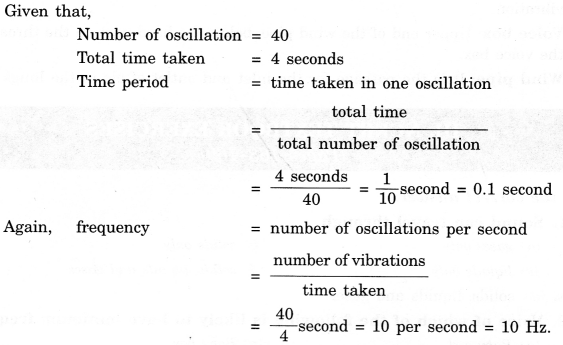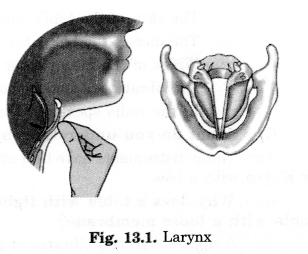NCERT Solutions for Class 8 Science Chapter 13 Sound are part of NCERT Solutions for Class 8 Science. Here we have given NCERT Solutions for Class 8 Science Chapter 13 Sound.
| Board | CBSE |
| Textbook | NCERT |
| Class | Class 8 |
| Subject | Science |
| Chapter | Chapter 13 |
| Chapter Name | Sound |
| Number of Questions Solved | 13 |
| Category | NCERT Solutions |
NCERT Solutions for Class 8 Science Chapter 13 Sound
NCERT TEXTBOOK EXERCISES
Question 1.
Choose the correct answer:
Sound can travel through
(a) gases only
(b) solids only
(c) liquids only
(d) solids, liquids and gases
Answer.
(d) solids, liquids and gases.
Question 2.
Voice of which of the following is likely to have minimum frequency?
(a) Baby girl
(b) Baby boy
(c) A man
(d) A woman
Answer.
(b) Baby boy.
Question 3.
In the following statements, tick ‘T’ against those which are true, and ‘F’ against those which are false:
- Sound cannot travel in a vacuum. (T/F)
- The number of oscillations per second of a vibrating object is called its time period. (T/F)
- If the amplitude of vibration is large, the sound is feeble. (T/F)
- For human ears, the audible range is 20 Hz to 20,000 Hz. (T/F)
- The lower the frequency of vibration, the higher is the pitch. (T/F)
- Unwanted or unpleasant sound is termed music. (T/F)
- Noise pollution may cause partial hearing impairment. (T/F)
Answer.
- True
- False
- False
- True
- False
- False
- True
Question 4.
Fill in the blanks with suitable words:
- Time taken by an object to complete one oscillation is called…….
- Loudness is determined by the………..of vibration.
- The unit of frequency is………….
- Unwanted sound is called……….
- The shrillness of a sound is determined by the.……….of vibration.
Answer.
- time period
- amplitude
- Hertz (Hz)
- noise
- frequency.
Question 5.
A pendulum oscillates 40 times in 4 seconds. Find its time period and frequency.
Answer.

Question 6.
The sound from a mosquito is produced when it vibrates its wings at an average rate of 500 vibrations per second. What is the time period of the vibration?
Answer.
Number of vibrations per second = 500
Time period = time is taken for one vibration

Question 7.
Identify the part which vibrates to produce sound in the following instruments:
- Dholak
- Sitar
- Flute
Answer.
- Stretched membrane
- String of sitar
- Air column.
Question 8.
What is the difference between noise and music? Can music become noise sometimes?
Answer.
The unpleasant sound is called noise, whereas a pleasant sound is called music. Noise can produce so many health hazards, whereas music brings about a soothing effect. Yes, music can become noise sometimes when the musical instruments produce very high volume sounds.
Question 9.
List sources of noise pollution in your surroundings.
Answer.
Following are the major sources of noise pollution:
- Sounds of vehicles.
- Sounds of the bursting of crackers and explosives.
- Sounds of loudspeakers, TVs, transistors.
- Sounds of kitchen appliances.
- Sounds of desert coolers, air conditioners etc.
Question 10.
Explain in what way noise pollution is harmful to humans.
Answer.
Noise pollution may cause many health-related problems.
- Lack of sleep, hypertension (high blood pressure), anxiety, etc. are some of the problems that may be caused due to noise pollution.
- A person who is exposed to a loud sound continuously may get temporary or even permanent deafness.
Question 11.
Your parents are going to buy a house. They have been offered one on the roadside and another three lanes away from the roadside. Which house would you suggest your parents should buy? Explain your answer.
Answer.
I would suggest my parents buy the house which is three lanes away from the roadside. This would protect us from noise pollution which is maximum on the roadside.
Question 12.
Sketch the larynx and explain its function in your own words.
Answer.
In humans, the sound is produced by the voice box or the larynx. It is situated in the throat. Below it is the windpipe. The two vocal cords are stretched across the voice box or larynx in such a way that it leaves a narrow slit between them for the passage of air when the lungs force air through the slit, the vocal cords vibrate and the vibration results in sound.

Question 13.
Lightning and thunder take place in the sky at the same time and at the same distance from us. Lightning is seen earlier and thunder is heard later. Can you explain why?
Answer.
The light travels at the speed of 3 x 10s ms-1, which is very large in comparison to the speed of sound which travels at the rate of 330 ms-1 in the air. That is why lightning is seen earlier and thunder is heard later.
We hope the NCERT Solutions for Class 8 Science Chapter 13 Sound helps you. If you have any query regarding NCERT Solutions for Class 8 Science 13 Sound, drop a comment below and we will get back to you at the earliest.